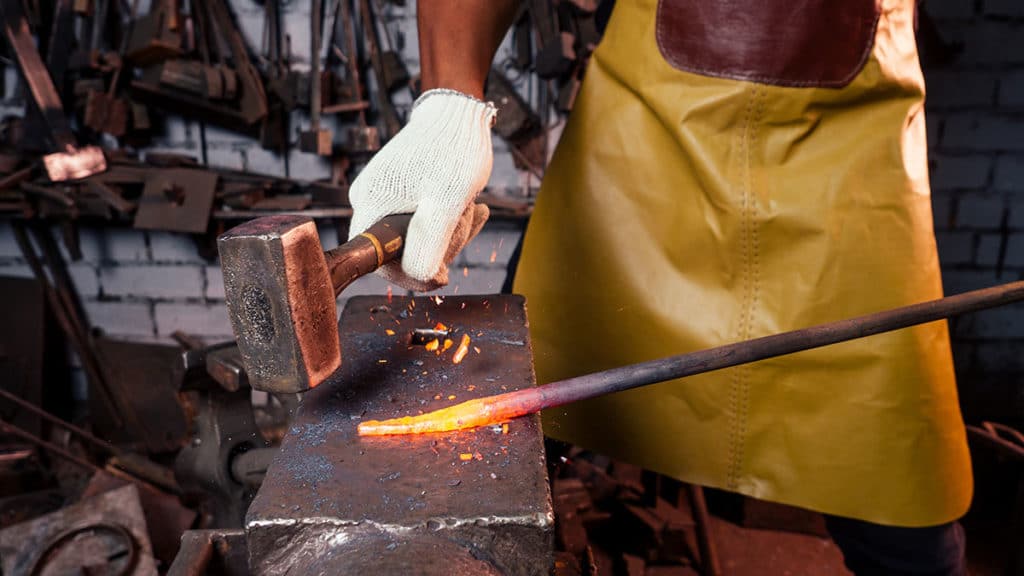
Celebrate Ogun, the Cuban Yoruba orisha of metal, technology, drivers and rum on June 29.
Who is Ogun?
[NOTE: These are oral traditions that vary by continent, region, town, and even by family. In Cuba, they are a blend of many traditions. This is my own cultural understanding.]
Ogun is the Yoruba orisha of metal, technology, drivers and rum. He is one of the Seven African Powers, and is said to have been the first king of Ife, the Yoruba holy city where the orishas came to Earth.
Ogun is often represented as a bare chested man in a tight hat, who lives alone in the forest, wears a grass skirt, and carries a machete. My gringo self used to see a grass skirt as something primitive, but it’s not. It’s symbolic.
Some stories say Ogun is the first orisha to come to Earth to see if it was ready to be populated. That may be why in the Americas, he is often syncretized with Saint Peter, the first among the Christian apostles. Both are owners of the keys to the kingdom of heaven.
Ogun is a hard worker who represents the duality of creation and destruction. He used his machete to clear a path through the forests for the other orishas to follow. So he destroyed the forest, but created a path.
He is one of the warrior orishas, but also has a gentle side. Ogun had some woman trouble for which he banished himself to the forest, but he is always around and willing to help his children when asked. His bitterness was calmed by Ochún, the beautiful young woman orisha.
In the Dominican Republic’s 21 Divisiones tradition, Ogun is Ogun Balenyo and syncretized with Santiago (Saint James). He is the patron saint of Santiago de los Caballeros, the DR’s second city, a market city in the fertile Cibao Valley. In Haiti, Ogun is called Ogoú Feraille or Ogou Feray. In Brazilian Candomblé, he is called Ogum (Yoruba tradition) or Gu (Fon tradition), and syncretized with Saint George. Ogun is also venerated in Trinidad through the Shango religion.
Symbols of Ogun
Ogun is a blacksmith. In his day, ironwork was high technology, so iron is one of Ogun’s symbols.
In the hunt, Ogun is helped by his dog, so a dog and dog barks are among his symbols.
His colors are green and black, so his followers wear alternating green and black bead necklaces.
His numbers are combinations of 3 and 7 which relate him to his brother Elegúa and mother, one of the paths of Yemayá. Ogun reinforces the paths that Elegúa opens.
Ogun’s grass skirt is not a sign of a primitive nature. He wears it for spiritual protection. You may see the same skirt in cultural presentations including Carnival characters.
The dance for Ogun mimics the chopping motion of his machete with dog barks and the clash of metal.
Aguanile
“Aguanile,” the famous salsa song from the Fania days, is actually a cleansing prayer to Ogun. “Aguanile” means clean yourself. The song gives me chills. Love it.
And you know it’s correct. People can point the way to a spiritual cleansing, but you have to take the steps yourself. You can go to someone for healing, but in most cases you have to heal yourself. ¡Aguanile!
African and Cuban Yoruba Traditions
There is a parallel universe in the African Diaspora, but you have to be taught how to read it. Otherwise, you can be looking right at it, but not know what you are looking at.
There is a logical progression to the orisha festivals. I long wondered why some orishas have two festival days. The reason is that African Yoruba traditions are aligned with Yoruba New Year on June 3, whereas Cuban traditions are aligned with European New Year on January 1.
Cuban Yoruba
- In Cuban, New Year is January 1st.
- When we start things we ask Elegúa, the owner of the crossroads of destiny to open a channel to the divine, on January 6, Three Kings Day.
- A few weeks later, we celebrate Ogun on January 29.
African Yoruba
- In Nigeria/Benin/Togo, Yoruba New Year is June 3.
- Near the start of the year, we celebrate Elegúa, on June 13. In New York City, this is the time of the National Puerto Rican Day Parade.
- A couple of weeks later, on June 29, we celebrate Ogun.
Elegúa opens the road with his staff, and Ogun keeps it clear with his machete. They work together.
Somehow, all of this is related. Aguanile.
